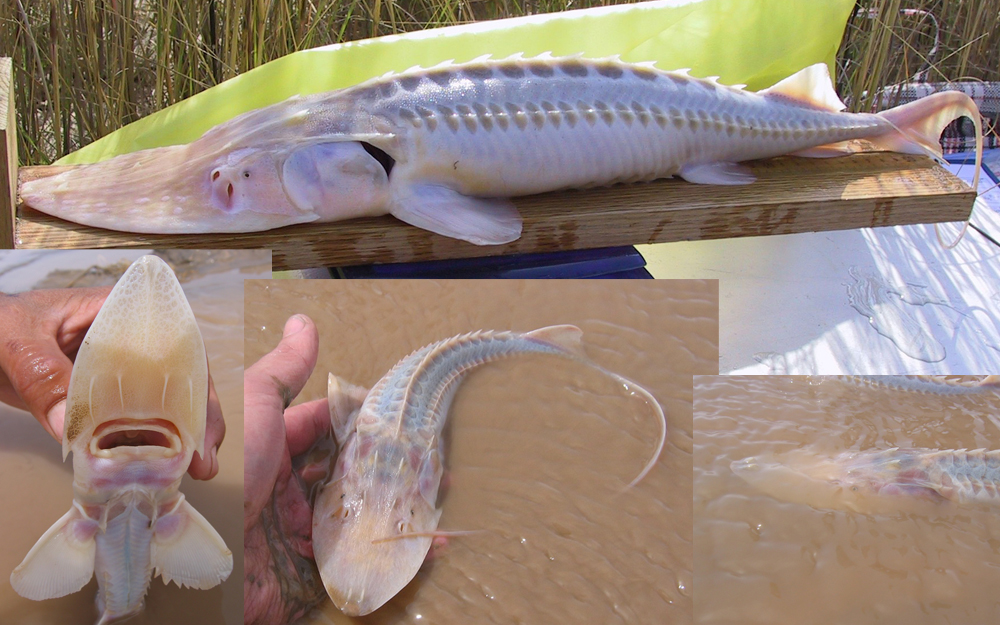Amu Darya sturgeon
(Pseudoscaphirhynchus kaufmanni)

Classification
The Amu Darya sturgeon or false shovelnose sturgeon (Pseudoscaphirhynchus kaufmanni) is a critically endangered species of fish in the family Acipenseridae. It is found in Turkmenistan and Uzbekistan, and perhaps Afghanistan and Tajikistan. It inhabits quite shallow flowing waters that are turbid and muddy.
The Amu Darya sturgeon is a small sturgeon, but the largest species of Pseudoscaphirhynchus, reaching up to 2 kg (4.4 lb) in weight and 75 cm (30 in) in total length, excluding tail filament.
It has a long, thin tail filament. For example, two individuals that both had a length of about 55 cm (22 in) excluding tail filament were 77 cm (30.5 in) and 85.5 cm (33.5 in) including tail filament. The species occurs in two morphs: a relatively large, light-coloured and late maturing morph, and a small, dark-coloured and early maturing morph. The small morph is roughly of similar size to P. hermanni, a species that lacks a tail filament.
The Amu Darya sturgeon feeds on small fish and aquatic insect larvae, with large individuals being mostly piscivorous.
Studies in the 1960s and 1970s showed that Amu Darya sturgeon reach maturity when 5–8 years old (slightly later in females than males), but in the 1990s the youngest mature individuals only were 4 years old, possibly due to environmental changes in their habitat. The breeding season is from March to May when the water is 14 to 16 °C (57 to 61 °F). During a season, a female of the large morph lays about 3,100–36,500 eggs and a female of the small morph about 1,000–2,000 eggs, but it is possible that they only do this every 4–5-year. The species can reach an age of more than 14 years. Historically, it was known to hybridize with P. hermanni, with the offspring having features that are intermediate between the two species.
Conservation status
The Amu Darya sturgeon once occurred throughout the Amu Darya river basin, including its delta in the Aral Sea, but today it is restricted to the middle Amu Darya River (between Chardzhou and Kerki) and the Vakhsh River (an Amu Darya tributary).
It has declined because of habitat loss, pollution and poaching, and is rated as critically endangered by the IUCN.
Despite its threatened status, strong decline and range contraction, it can be locally fairly common and overall it is the least rare species of Pseudoscaphirhynchus (P. fedtschenkoi is possibly extinct and P. hermanni only survives in very small numbers).
In general the status of the Amu Darya sturgeon is poorly known and further surveys are necessary. A part of its range is in the Amudarya State Nature Reserve. Although the Amu Darya sturgeon is a fully protected species throughout its range, illegal fishing is widespread and fisheries management in the region is very poor. The species has been listed on CITES Appendix II since 1998. This restricts international trade in the species, but two were legally exported from Uzbekistan to Russia for zoological purposes in 2002–2012, and in 2013 Uzbekistan set the export quota to twenty individuals.
Many sturgeon species have been bred in captivity and this often forms the basis for restocking the wild populations. In the 1980s there were attempts of doing this with the Amu Darya sturgeon. Although some progress was made, captive breeding ultimately failed because the embryos died. Since 2010, the Moscow Zoo (together with various Russian institutes and officials of Tajikistan and Uzbekistan) has attempted to start a breeding program for the Amu Darya sturgeon, but as of 2015 it has not succeeded.










